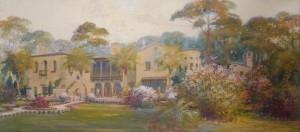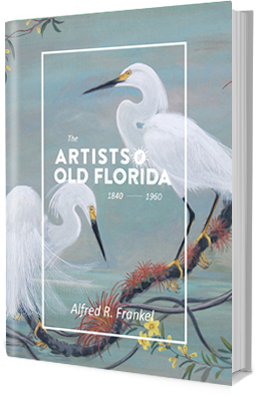It was back about 1989 that I first met Asa Cassidy. Asa had been dead forty-three years. I was walking down an isle approaching Mike Turbeville’s booth at the Larry Engle Antiques Show. Mike had, in my opinion, the best booth at the show, but back then few people seemed interested in Florida antiques. Incredibly, I was probably his best customer. Entering the booth was like entering my living room on Christmas morning as a kid, full of goodies. I had to remind myself to be cool or his price might go up.
Here hanging on a side wall was a small part of the gift Asa Cassidy has left the state of Florida. The gift was a painting of a group of sea gulls hovering over a blue green sea, with puffs of Florida clouds hanging behind them. I loved it. Mike explained that the painting had been done by an artist who lived in Tampa back in the 1950’s. A few hours later my wife Barbara and I happily took the painting home to our condo on the beach.
The painting was hung in our living room and admiring it. I wondered what else this fellow had painted.
Two or three years later I got a call from Mike. He was in Clearwater and had found a Florida painting. It was in the rear section of a high end antiques shop with the less desirable merchandise. “Hey, what was the name of that artist you liked so much who did the seagulls? Was it Asa Cassidy?” “Yes it was!” A few days later I met with Mike. Asa had painted a grand Spanish style mansion with spring flowers in bloom. It wow a neat picture and the original owner had written on the back, “Paid the artist $500 for this in 1930.” I bought the painting and told my wife this was probably an important home somewhere in the Tampa Bay area and that someday we’d find it.
One afternoon I was at the Sarasota Historical Research Center on Route 41 trying to learn more about early Florida artists. While looking through the 1926 Sarasota city directory, I was surprised to find a listing for Asa Cassidy, with a studio on the third floor of the Blackburn Building. This is the same year the Sarasota Art Association was founded. Many of the Sarasota directories have been lost but, according to a 1940 issue, Asa still had a studio there.
Several months later, having been in the center a few times, I talked to one of the curators and explained that I knew Asa Cassidy had been one of the first artists in Sarasota and that I just couldn’t find anything more about him. “Asa Cassidy,” she said, “I think we have one of his paintings; just a minute.” She walked to a back room and then, turning back, asked me to follow her. Walking up a flight of wooden stairs, my head peaked above the second floor landing and I could see a painting leaning against the rear wall. Here was Asa Cassidy once again! In front of me was a three by five foot painting of a 1920’s bathing beauty riding the back of a tarpon in Sarasota Bay. Wow! Titled, The Spirit of Sarasota, it was pure 1920’s Florida. The painting had hung in the Sarasota city hall for years and the image was once used as a logo on Sarasota Chamber of Commerce stationery and advertising brochures.
I learned that Cassidy had been a lithographer in New York City and was associated with the early motion picture industry. He designed all the sets and advertising posters for D. W. Griffith’s, The Birth of a Nation. Cassidy painted portraits of Mary Pickford, Enrico Caruso and the naturalist, John Burroughs. In 1921 he sold his business and moved to Florida to spend more time painting.
In the spring of 1997 Barbara and I were at the Manatee County Historical Park. We were leaving the country store when we noticed a poster on a bulletin board announcing that the Crosley Mansion was being restored and was open to the public for a “designer showcase,” The photograph of the mansion looked familiar. A painting of a similar Spanish home was hanging in our living room. The mansion was open that day and we rushed down to see it. Was it Asa’s home? The long driveway from Route 41 led us to the rear of a great home. The front of the building faced Sarasota Bay. We cautiously walked around to the front. Yes! This was the home Asa Cassidy painted for John Crosley in 1930, the year the house was finished. Crosley, a multimillionaire, was the maker of the Crosley refrigerator, the Crosley car, and the Crosley radio. He built his home just south of the Ringling Museum and John Ringling’s home Ca da San. We were getting to know Asa better
Asa Cassidy was also a poet. He self-published two books: the first, Who Knows, published in Tampa in 1931, is a thoughtful collection of poems on the meaning of life. The dedication reads as follows:
To my wife, Mary Josephine, whose companionship has been my
greatest joy, who’s suffering my greatest sorrow-whose patience,
cheerfulness and courage my greatest inspiration for a fuller and
more rational understanding of life, this volume is reverently
dedicated. If, even in a small way, it shall assist mankind to a saner or
More hopeful outlook, my purpose will have been achieved.
Asa Cassidy.
Cassidy’s second book, The Rubbernex in Florida, published in Tampa in 1938, is a happy story of a family tour through Florida by car. Starting in Jacksonville, Cassidy takes us on a rhyming road down the east coast to Key West and then across the state to Ft. Myers and up the west coast to the Suwanee River.
Pa, “Well come on Ma! Get ready Rex,
And all you little Rubbernex!
Let’s get away from slush and snow
To where the summer breezes blow
And flowers bloom and trees are green!”
Ma: “ Why! Florida’s the place you mean!”
Pa: “Yes, Florida, the brightest gem
In nature’s brillinant diadem.
Her lure enthralls me and I fain
Would revel in her charms again-
Would breathe the perfume of her air
And bask in laughing sunshine there.
The beauty of her beaches white
And glamorous magic of her night
Have cast a spell that calls me on.”
Said Ma, “Then, Pa, why not be gone?”
One afternoon I was antiquing in Tarpon Springs as I do every few months. Over the years I’ve found some great things. I wandered down one side of the street, winding in and out of antiques shops: nothing. I crossed the street and began the same familiar pattern. In the next to the last shop, I slowly browsed my way to the back and was suddenly startled to see a beautiful painting of two pelicans. I immediately thought of an Orlando artist, Sam Stoltz, but I bent down to find my old friend, Asa Cassidy. On the back of the canvas Cassidy had written: “That wonderful bird, the pelican.”
The New York Times tell us that in 1942 Cassidy was in the Bahamas where he was probably the first, if not the only painter to do a canvas while underwater. Using a $50,000 bell-shaped diving device equipped with windows, he averaged four hours a day down in the diving bell over several months. Depicting marine flora and fauna, Cassidy entitled the painting, The Garden Spot of the Sea.
Sometime before 1934 Cassidy moved to West Platt Street in Tampa. He was elected an honorary member of the Tampa Art Institute. Cassidy died of a stroke on February 19, 1946 at the age of 81. In his obituary the Tampa Tribune called him, “An outstanding artist….nationally known.”
Asa Cassidy was a good deal more than just an outstanding artist. Having read his poetry and seen his paintings, Cassidy was clearly a warm, thoughtful gentleman, full of happiness and the joy of life. With the soul of a poet, he spent a good deal of his life celebrating the Florida he loved so much.
Well that’s Asa Cassidy. I hope you liked meeting him. It was a privilege to introduce him to you. Someday, when you’re out antiquing, if you’re lucky, you may suddenly turn a corner and meet him again.




